I have a comfortable life, with secure sources of food and drinkable water, notwithstanding the understandable recent outcry about increased pollution in the nearby river Thames, and the likelihood of hosepipe bans given the national shortage of storage capacity. What follows is an account of recent weeks during which I’m aware that further afield devastating floods have affected many farming areas in Britain, and water security globally, in its many aspects, is becoming an ever more urgent issue.
Into Each Life Some Rain Must Fall
…and hereabouts that has meant pots and containers carrying much more weight than usual at this time of year as the onslaught of wind and very heavy rains has continued through the Winter and now into Spring. Rotating the pots that I usually move around with ease, as various Spring bulbs spring into flower, has been very much harder this year. True I am a year older, and have been officially elderly for some while, but more telling, I think, is the excess water in the containers, confirmed by the puddles left behind any pot I do eventually manage to shift.
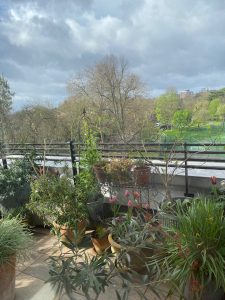 Meanwhile I try and ensure that glimpses of the balcony from indoors include anything in flower, and that the wider view is not obscured. For now this extends across South London and beyond, as far as edge of the North Downs Surrey Hills rising behind the unmissable white buildings of St Helier Hospital in clear view, on a clear day, from our bedroom or balcony. Once the tall deciduous trees closer by have formed a leafy enclosure the view is gone for a while, but for now the hope is to capture sight of the blossom further afield, as well as nearby, and make the most of the sparse colour immediately around.
Meanwhile I try and ensure that glimpses of the balcony from indoors include anything in flower, and that the wider view is not obscured. For now this extends across South London and beyond, as far as edge of the North Downs Surrey Hills rising behind the unmissable white buildings of St Helier Hospital in clear view, on a clear day, from our bedroom or balcony. Once the tall deciduous trees closer by have formed a leafy enclosure the view is gone for a while, but for now the hope is to capture sight of the blossom further afield, as well as nearby, and make the most of the sparse colour immediately around.
Locally the problem of spillages into rivers is gaining more urgency and a (partial) solution is in sight as the Tideway super sewer is due to be opened next year, but more immediately a leak into the property underneath is ever more probable. Old construction methods, I have recently learnt, relied primarily on asphalt and exceptionally heavy slabs to ensure that the surface of the balcony provides protection from the elements for our neighbours on the floor below, while we can enjoy the outdoor space surrounding our corner property, bedecked as it is with plants for all seasons.
Modern materials are much lighter and have been used to resurface most of the building’s balconies and part of ours but not the main area. A combination of pressure on funds and the lockdown brought things to a juddering halt. So in order to lessen the load I have now jettisoned a number of containers; ones with rotten bottoms were taken to the tip, others to the allotment to be used for strawberry plants and herbs and yet more relocated to the already re-surfaced section of the balcony. But this may really amount to a drop in the ocean as the main contributor to the weight are the slabs and the largest containers remain in situ.
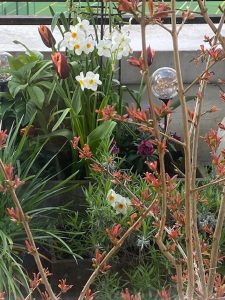 The work will need to be done, and in anticipation I need to be prepared to let common sense prevail as it would be a golden opportunity to swap my selection of clematis growing in tall, slim, containers, currently surrounding the main balcony, for the array of large awkward planters, with their spreading, ungainly contents (selecting roses for their beauty rather than their restrained growth habit seems rather unwise now) on the narrow pathway alongside the bedroom windows. Why not? It would mean anyone who needs access to this seldom visited sun-soaked east, south-east facing aspect of our territory would be able to approach it on foot rather than clambering along the parapet wall to avoid the prickly plants, or out of windows, currently my only access.
The work will need to be done, and in anticipation I need to be prepared to let common sense prevail as it would be a golden opportunity to swap my selection of clematis growing in tall, slim, containers, currently surrounding the main balcony, for the array of large awkward planters, with their spreading, ungainly contents (selecting roses for their beauty rather than their restrained growth habit seems rather unwise now) on the narrow pathway alongside the bedroom windows. Why not? It would mean anyone who needs access to this seldom visited sun-soaked east, south-east facing aspect of our territory would be able to approach it on foot rather than clambering along the parapet wall to avoid the prickly plants, or out of windows, currently my only access.
It would also mean an admission, to myself, that making all sorts of sensible future-proofing decisions in other aspects of my life, but continuing to negotiate the waist high windows in order to tend to the plants is rather foolish when another possibility might be forthcoming. I would have to relinquish the ritual of using a wooden chair as a step-ladder, propping open the sash window with a prepared length of wood (actually I have three of different lengths painted the same colour as the walls to avoid attracting too much attention) protecting the carpet from spillages with old towels kept for the occasion, and keeping my mobile phone to hand, but out of the way, while hoping no-one is watching this complicated manoeuvre involving first sitting on the window sill, then sliding my legs down onto the balcony (often a shoe, chosen for its age and flexibility, falls off at this point) while keeping my upper body in a crouched position so my head and shoulders can pass through the gap under the sash window and join my feet and legs on the balcony. It requires ingenuity and some flexibility, which I still have, but is a faintly ridiculous enterprise although probably less risky than climbing the tall step-ladder necessary to water some of my house plants.
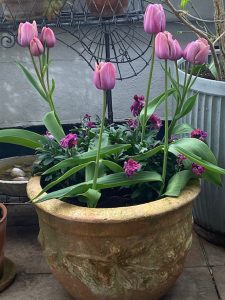 My other worry through the Winter has been the effect, particularly on the larger Mediterranean plants, and most particularly on the olives, of effectively standing in cold water for months on end. I needn’t have worried. They have all flourished and the larger plants, now very definitely small trees, are producing healthy new growth much earlier than usual in my gardening year. It’s a fine line it seems, because according to ‘Olive Grove’, although olives need good drainage, they should be kept moist at all times when grown in a pot. I must remember to do more watering, as long as rain isn’t forecast. My hebe, on the other hand, has responded to the relatively mild winter by springing into flower again, after being bought last year at the helpful suggestion of a cousin to provide Autumn colour. Henceforth I will enjoy it whenever it puts on a show.
My other worry through the Winter has been the effect, particularly on the larger Mediterranean plants, and most particularly on the olives, of effectively standing in cold water for months on end. I needn’t have worried. They have all flourished and the larger plants, now very definitely small trees, are producing healthy new growth much earlier than usual in my gardening year. It’s a fine line it seems, because according to ‘Olive Grove’, although olives need good drainage, they should be kept moist at all times when grown in a pot. I must remember to do more watering, as long as rain isn’t forecast. My hebe, on the other hand, has responded to the relatively mild winter by springing into flower again, after being bought last year at the helpful suggestion of a cousin to provide Autumn colour. Henceforth I will enjoy it whenever it puts on a show.
Here Comes the Sun
Recently, while enjoying lunch with friends, two of us were trying to reassure our ‘newer to gardening’ friend, with a newly constructed, multi layered city garden, and plants happily growing in different mediums and with various histories, that there are pleasures in learning a certain amount from gardening articles (of which there is no shortage), understanding certain principles (right plant, right place and exposed south facing sites won’t help shade loving plants to thrive), ‘free’ plants are available if you divide herbaceous plants (best in the Autumn but anytime is often possible) and killing plants is often harder than you think. Sadly though, with the best will in the world, although most plants manage to cope with neglect and other hardships some don’t.
I still pine for foxgloves although it dawned long ago that high rise living on a windy South facing terrace was a stretch too far for these woodland treasures, lovers of damp soil and dappled light. I also yearn for a shady spot to read or escape from the world. Actually the lockdown taught me that with the parasol up and securely anchored, clematis and rosemary providing additional cover and a few comfy cushions and a cup of tea, the bench offers a pleasurable escape with the opportunity to chat over the railings too if anyone’s around and I lift my head above the parapet. Not quite the same as the shade of the spreading walnut tree of my childhood, but a very close second best and not so far to carry the aforementioned cup of tea.
And if you are anywhere near the Brecon Beacons, Nant-y bedd https://nantybedd.com/ is a woodland garden with foxgloves all around, ‘as focal points or flowering en masse’. More immediately, the hedgerows on either side of the narrow Cornish lanes, and particularly the stonewalls, are bedecked with purple pink foxgloves wherever you look in early Summer. Seemingly rather smaller and less vibrant than their woodland counterparts they are nevertheless a delight alongside wild garlic, cow parsley and much more, all of which, thrive at the base or in the damp crevices of the characteristic stone walls, often in very exposed positions.
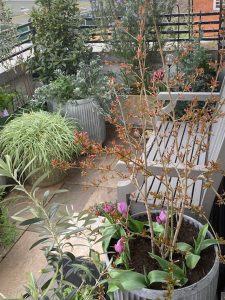 My parents, but particularly my father, liked eating outdoors whenever possible and the lawn under the walnut tree was the designated spot for these alfresco meals. However, without the ease of spilling out from indoors onto a paved area replete with table and chairs, it was a hazardous treck to and from the kitchen. The trolley carrying most of the food had to negotiate the journey through the house, across a veranda (which had enough space for one or two comfy chairs well protected from wind and rain but not a table and chairs) and down various steps, so I was less enthusiastic. Meanwhile all the heavy, cumbersome garden furniture had to be retrieved and set up for each meal to avoid any lasting damage to the lawn. I don’t actually remember anything about the food, except that there was no concession to eating outdoors so anything hot would quickly become cold, as the trolley pre-dated ‘hostess models’, but I do remember flapping table cloths when the wind got up and dashing indoors when the rain came. I also remember long leisurely conversations amongst the ‘grown-ups’ and rather more freedom to come and go for anyone younger.
My parents, but particularly my father, liked eating outdoors whenever possible and the lawn under the walnut tree was the designated spot for these alfresco meals. However, without the ease of spilling out from indoors onto a paved area replete with table and chairs, it was a hazardous treck to and from the kitchen. The trolley carrying most of the food had to negotiate the journey through the house, across a veranda (which had enough space for one or two comfy chairs well protected from wind and rain but not a table and chairs) and down various steps, so I was less enthusiastic. Meanwhile all the heavy, cumbersome garden furniture had to be retrieved and set up for each meal to avoid any lasting damage to the lawn. I don’t actually remember anything about the food, except that there was no concession to eating outdoors so anything hot would quickly become cold, as the trolley pre-dated ‘hostess models’, but I do remember flapping table cloths when the wind got up and dashing indoors when the rain came. I also remember long leisurely conversations amongst the ‘grown-ups’ and rather more freedom to come and go for anyone younger.
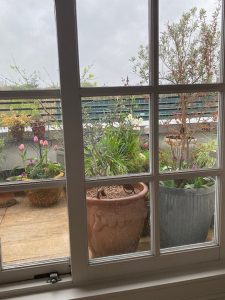 Although my father was a firm believer in democracy it didn’t seem to apply when faced with our protests at the labour involved in setting up these overly complex traditional lunch-time meals, and the hazards we faced when opening out the heavy folding table or moving hot food down several steps. In retrospect I think I almost certainly gained a lot following his observations of the garden over lunch; what was working well, what needed pruning and so on, while my mother tried hard to introduce us to the songs of the various visiting birds. All of which was somewhat curtailed as we got older and more independent, and ended following one hot and humid night when my father, asleep on the camp bed set up on the veranda, woke in terror when our pet cat landed on top of him seeking company and comfort presumably, after which most of the outdoor furniture, including the ancient camp bed, was thankfully put into deep storage.
Although my father was a firm believer in democracy it didn’t seem to apply when faced with our protests at the labour involved in setting up these overly complex traditional lunch-time meals, and the hazards we faced when opening out the heavy folding table or moving hot food down several steps. In retrospect I think I almost certainly gained a lot following his observations of the garden over lunch; what was working well, what needed pruning and so on, while my mother tried hard to introduce us to the songs of the various visiting birds. All of which was somewhat curtailed as we got older and more independent, and ended following one hot and humid night when my father, asleep on the camp bed set up on the veranda, woke in terror when our pet cat landed on top of him seeking company and comfort presumably, after which most of the outdoor furniture, including the ancient camp bed, was thankfully put into deep storage.
Flower Power
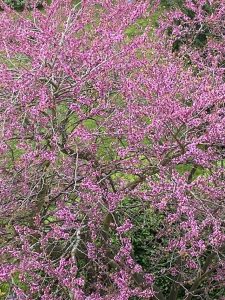 In the grounds down below resilient plants, many of them evergreens, occupy most of the shrubberies, with a designated wild flower area and some carefully chosen planting in key areas competing for attention, surrounded by majestic lime trees and poplars as well as London planes planted long ago. But at this time of year, when the snowy white cherry blossom has come and gone, it is the Judas Tree, Cersis siliquastrum (planted in 1953), with its deep pink flowers, some growing directly on the trunk, which is particularly captivating and a sure sign of Summer to come.
In the grounds down below resilient plants, many of them evergreens, occupy most of the shrubberies, with a designated wild flower area and some carefully chosen planting in key areas competing for attention, surrounded by majestic lime trees and poplars as well as London planes planted long ago. But at this time of year, when the snowy white cherry blossom has come and gone, it is the Judas Tree, Cersis siliquastrum (planted in 1953), with its deep pink flowers, some growing directly on the trunk, which is particularly captivating and a sure sign of Summer to come.
 On the balcony however, I have to accept that while the rosemary, hellebores, various narcissi, grape hyacinths and early clematis are happily in flower, the roses are looking promising and new growth is all around, my choice of tulips has yet again been very disappointing. In the Autumn I veer between being overambitious and select tulips that are too tall, too extravagant and too dramatic in colour (magenta and orange doesn’t work close up but is probably magnificent from a distance) and being too mean, planting too few bulbs where more would look much prettier or make more impact. I’m also going to avoid dwarf wallflowers another year too. The plants are dwarf sized in height which is good for containers, but so are the flower spikes, so less good for containers if you want eye-catching flowers to attract your gaze. The combination is a faintly absurd picture with the tulip flowers towering over the wallflowers below – the beautiful terracotta pot deserves better so I have lined up a rose to be planted as soon as possible.
On the balcony however, I have to accept that while the rosemary, hellebores, various narcissi, grape hyacinths and early clematis are happily in flower, the roses are looking promising and new growth is all around, my choice of tulips has yet again been very disappointing. In the Autumn I veer between being overambitious and select tulips that are too tall, too extravagant and too dramatic in colour (magenta and orange doesn’t work close up but is probably magnificent from a distance) and being too mean, planting too few bulbs where more would look much prettier or make more impact. I’m also going to avoid dwarf wallflowers another year too. The plants are dwarf sized in height which is good for containers, but so are the flower spikes, so less good for containers if you want eye-catching flowers to attract your gaze. The combination is a faintly absurd picture with the tulip flowers towering over the wallflowers below – the beautiful terracotta pot deserves better so I have lined up a rose to be planted as soon as possible.
But there is good news too – my pomegranate, which I carefully pruned a few weeks ago, is full of healthy growth, but no flowers so presumably no fruit this year. I’ve successfully overwintered my trailing pelargonium ‘Surcouf‘, with its edible bright pink flowers, and pretty leaves, which I’m pleased about as this particular plant has now been outdoors for over two and a half years. And all the silver evergreens, like the olives, are thriving.
Many thanks for all your comments, which like other anticipated or impromptu gardening conversations, I enjoy and learn from, and space permitting put into practice.





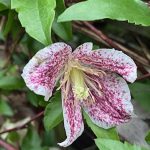



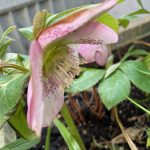

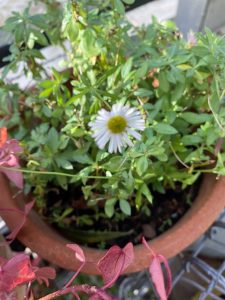

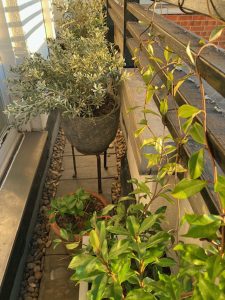
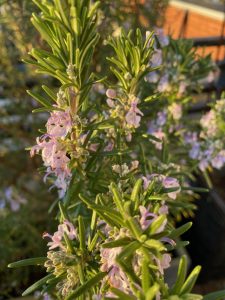

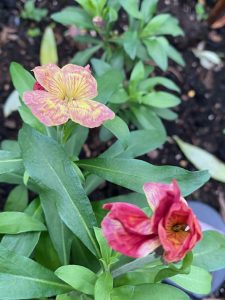





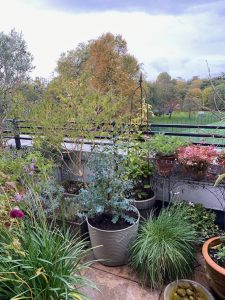

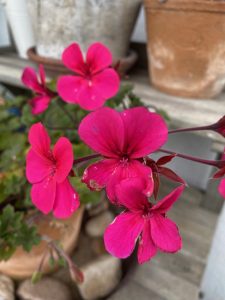
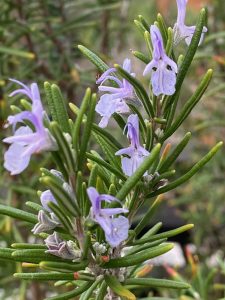
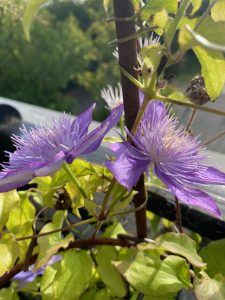
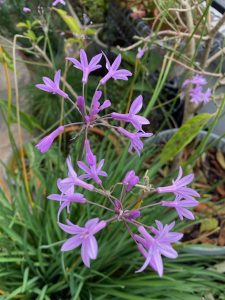
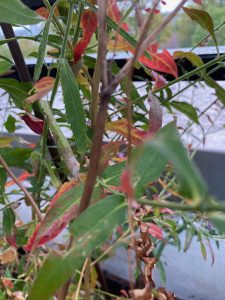
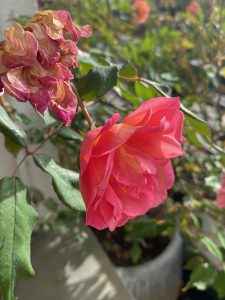
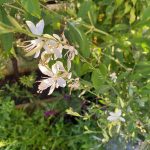


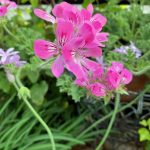
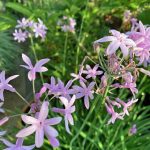
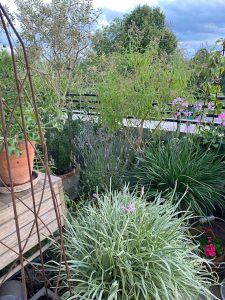
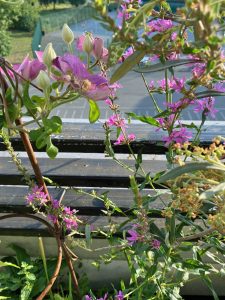
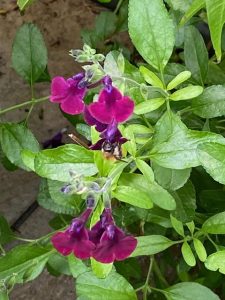
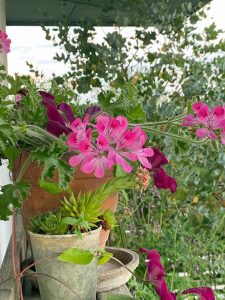
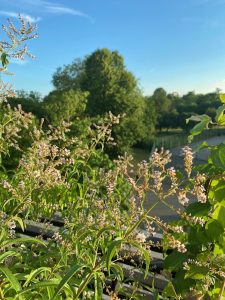
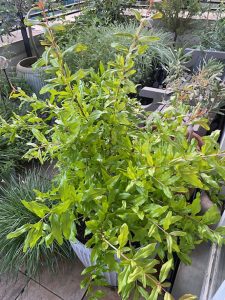
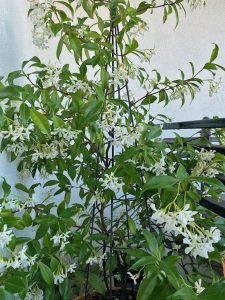





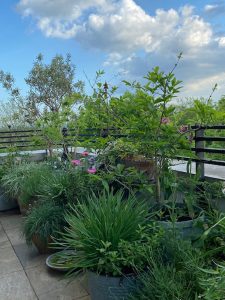
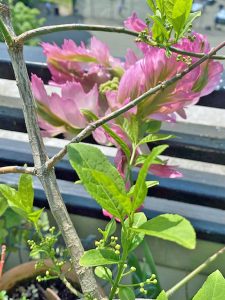
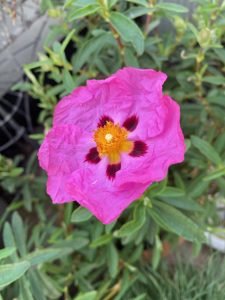
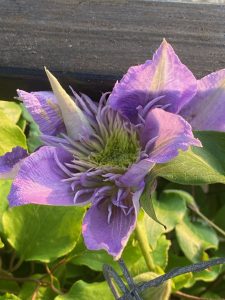
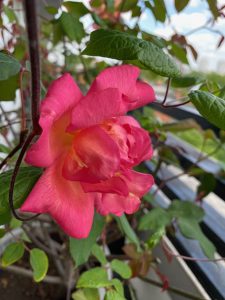
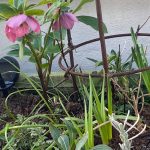


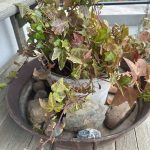

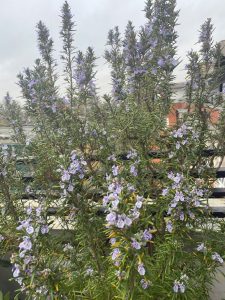
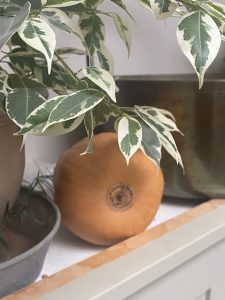








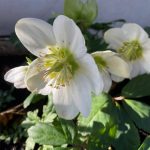
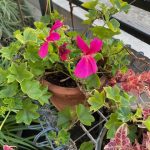

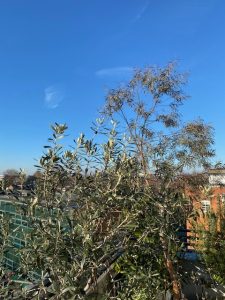
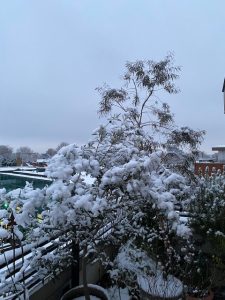
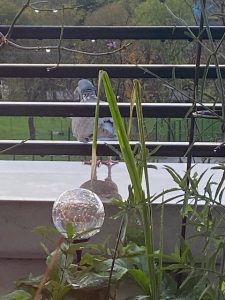
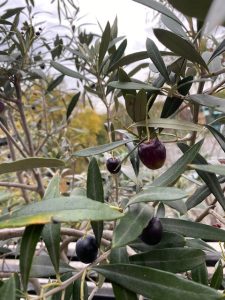





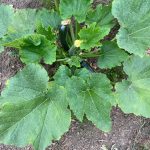


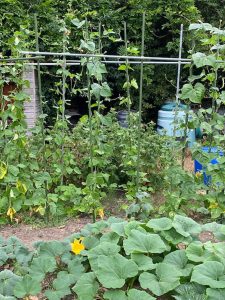
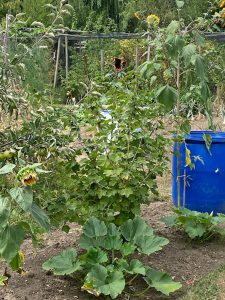
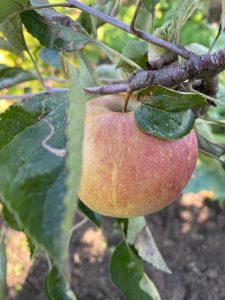






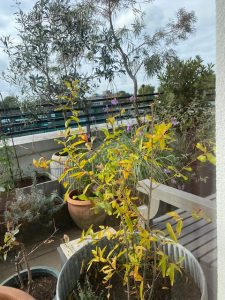
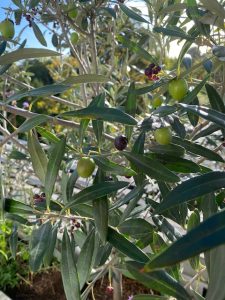

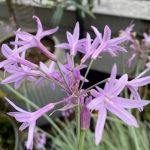




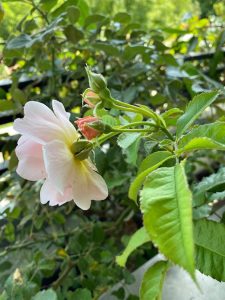
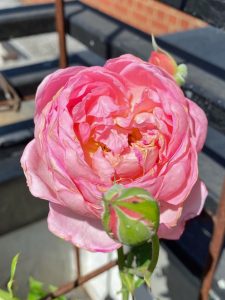
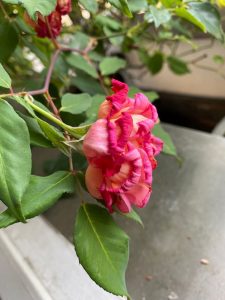
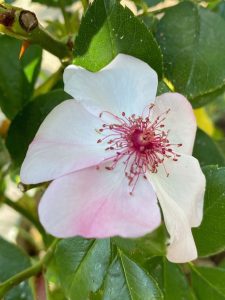
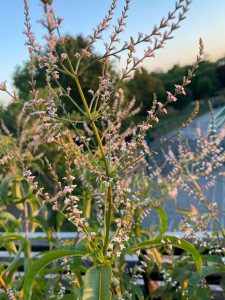
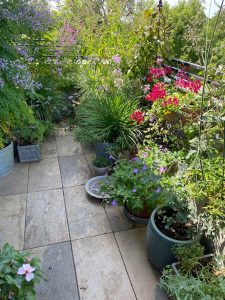 t beginning to swell and the parched ground below is very evident.
t beginning to swell and the parched ground below is very evident.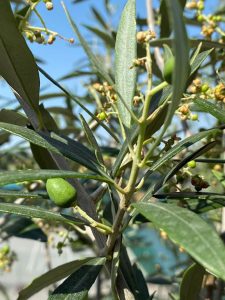
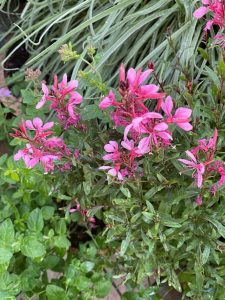
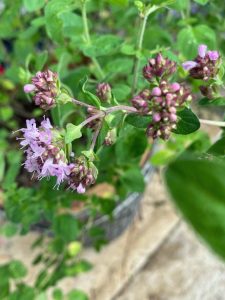
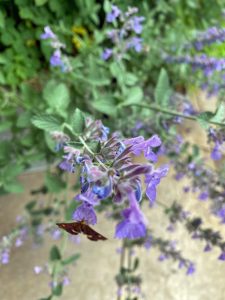
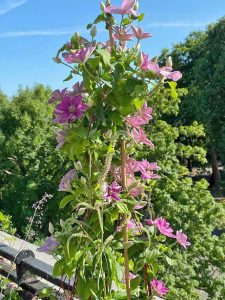
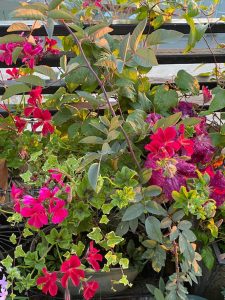
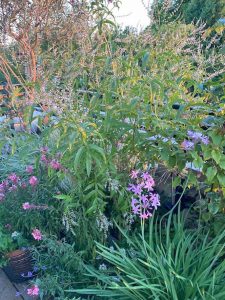

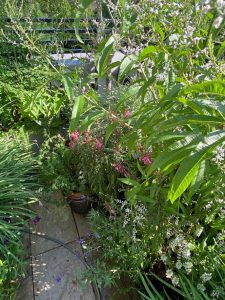
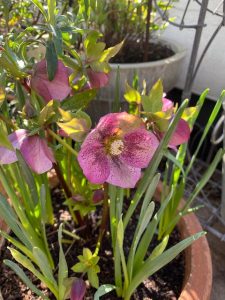
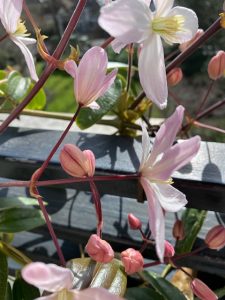
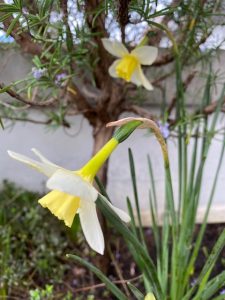
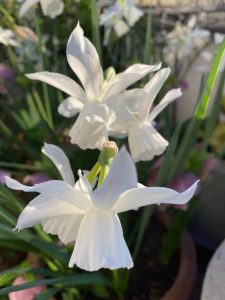

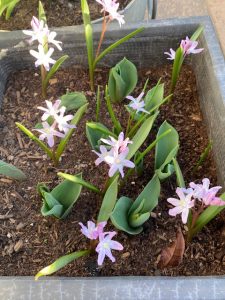 The rose was unscathed but much plant life across the country was irrevocably lost or damaged – heartbreaking and worrying for individual gardeners, all plant lovers, and many others, but trees and ornamental plants have considerable powers of recovery. Nearby, Spring has arrived in Richmond Park and the scars of Winter are in retreat thanks both to the wonders of nature and the park’s workforce, guardians of both the trees and the deer who live amongst them, eating grass and leafy shoots.
The rose was unscathed but much plant life across the country was irrevocably lost or damaged – heartbreaking and worrying for individual gardeners, all plant lovers, and many others, but trees and ornamental plants have considerable powers of recovery. Nearby, Spring has arrived in Richmond Park and the scars of Winter are in retreat thanks both to the wonders of nature and the park’s workforce, guardians of both the trees and the deer who live amongst them, eating grass and leafy shoots.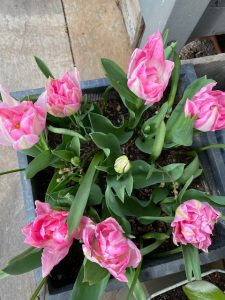
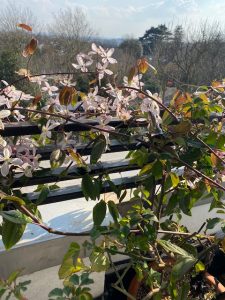

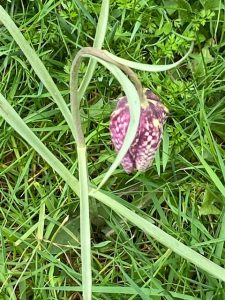 Gardens and gardening are often sociable spaces and activities. Admiring comments are always welcome, help and advice is often freely given and seeds and produce exchanged, and the possibility of contributing to the wider green agenda is rewarding too. Down below the grass bordering the parking area is managed as a wildflower meadow with snake’s head fritillaries now appearing at intervals, hopefully with more to come next year. What’s missing in this urban space is the peace and quiet of the countryside and the views beyond. Of course struggling with a yearning for a bigger space isn’t always easy, but nature has a foothold hereabouts and you might be surprised how successful awkward urban spaces can be at providing calming plant filled oases in a built up area and are increasingly popular with pollinators.
Gardens and gardening are often sociable spaces and activities. Admiring comments are always welcome, help and advice is often freely given and seeds and produce exchanged, and the possibility of contributing to the wider green agenda is rewarding too. Down below the grass bordering the parking area is managed as a wildflower meadow with snake’s head fritillaries now appearing at intervals, hopefully with more to come next year. What’s missing in this urban space is the peace and quiet of the countryside and the views beyond. Of course struggling with a yearning for a bigger space isn’t always easy, but nature has a foothold hereabouts and you might be surprised how successful awkward urban spaces can be at providing calming plant filled oases in a built up area and are increasingly popular with pollinators.